MBA Dissertation PGBM73: UAE Restaurant Promotional Strategies
VerifiedAdded on 2020/03/01
|86
|19817
|49
Thesis and Dissertation
AI Summary
This MBA dissertation evaluates the effectiveness and appropriateness of promotional strategies employed by Parker's and Switch restaurants in the UAE. The research, conducted for the University of Sunderland London Campus, examines the impact of the promotional mix, including advertising, personal selling, sales promotion, and public relations, on consumer decision-making. The study employs a qualitative approach, surveying customers to understand how various promotional tools influence their choices. The research aims to provide insights into the best practices for promotional marketing in the UAE restaurant market, considering the competitive landscape and limited resources of small and medium enterprises. The dissertation includes a literature review of promotional mixes, research methodology with data analysis, and conclusions with recommendations for the restaurant industry in the UAE. The study emphasizes the importance of market analysis and adapting promotional strategies to the specific needs of the target market within the UAE's hotel industry. The findings suggest that a deep understanding of the external business environment is essential for establishing a successful business in the UAE's hotel and restaurant sector.
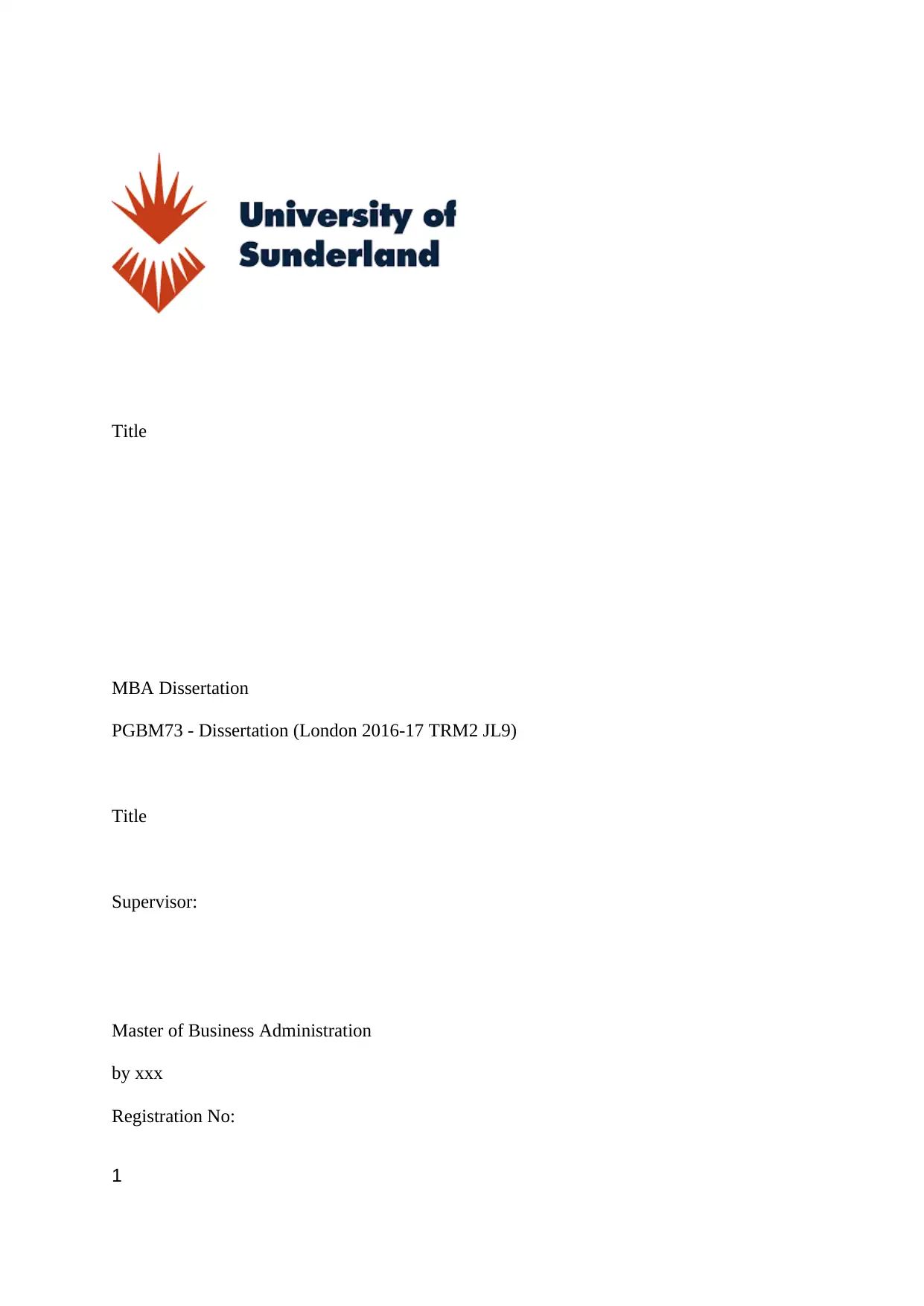
Title
MBA Dissertation
PGBM73 - Dissertation (London 2016-17 TRM2 JL9)
Title
Supervisor:
Master of Business Administration
by xxx
Registration No:
1
MBA Dissertation
PGBM73 - Dissertation (London 2016-17 TRM2 JL9)
Title
Supervisor:
Master of Business Administration
by xxx
Registration No:
1
Paraphrase This Document
Need a fresh take? Get an instant paraphrase of this document with our AI Paraphraser
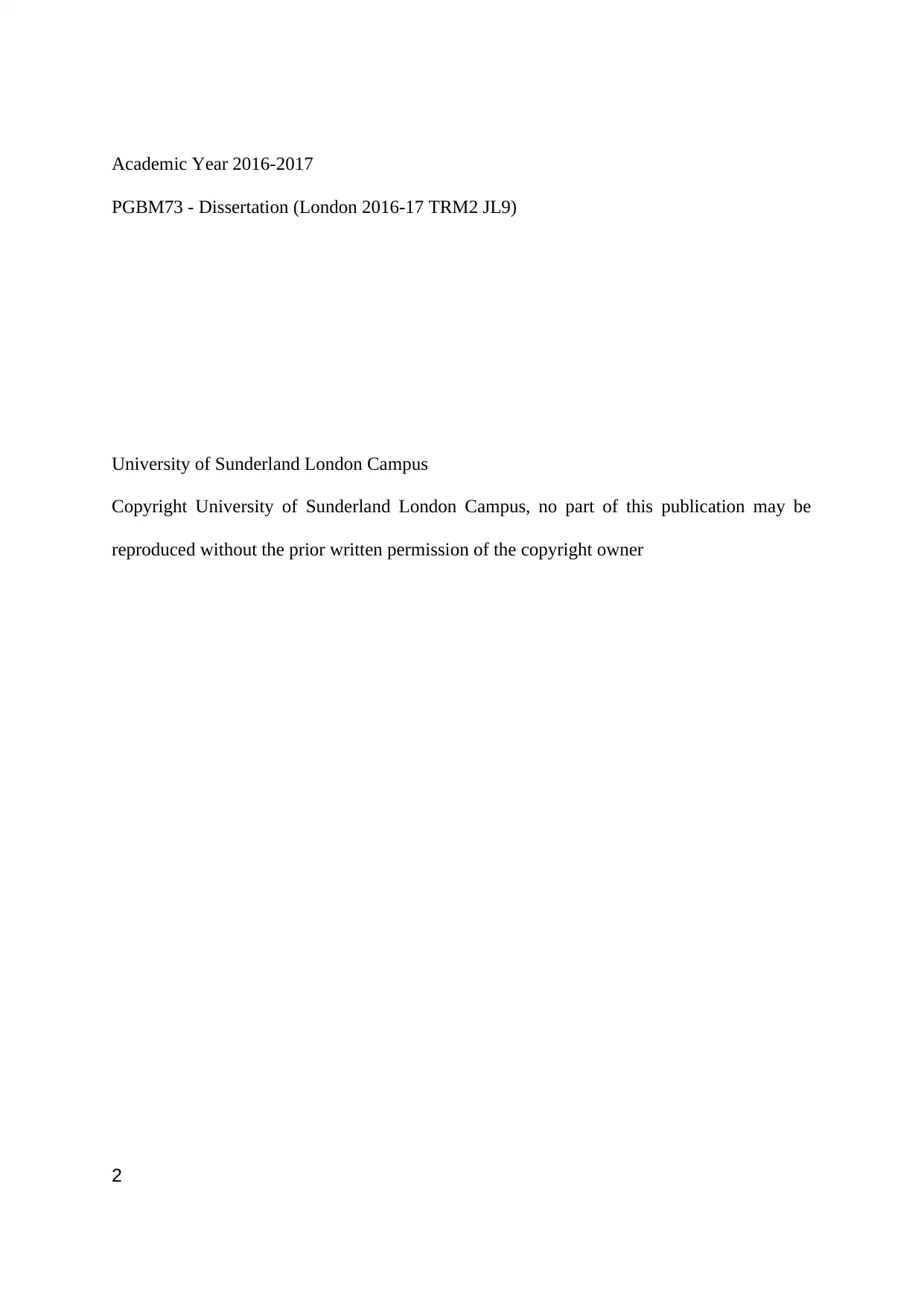
Academic Year 2016-2017
PGBM73 - Dissertation (London 2016-17 TRM2 JL9)
University of Sunderland London Campus
Copyright University of Sunderland London Campus, no part of this publication may be
reproduced without the prior written permission of the copyright owner
2
PGBM73 - Dissertation (London 2016-17 TRM2 JL9)
University of Sunderland London Campus
Copyright University of Sunderland London Campus, no part of this publication may be
reproduced without the prior written permission of the copyright owner
2
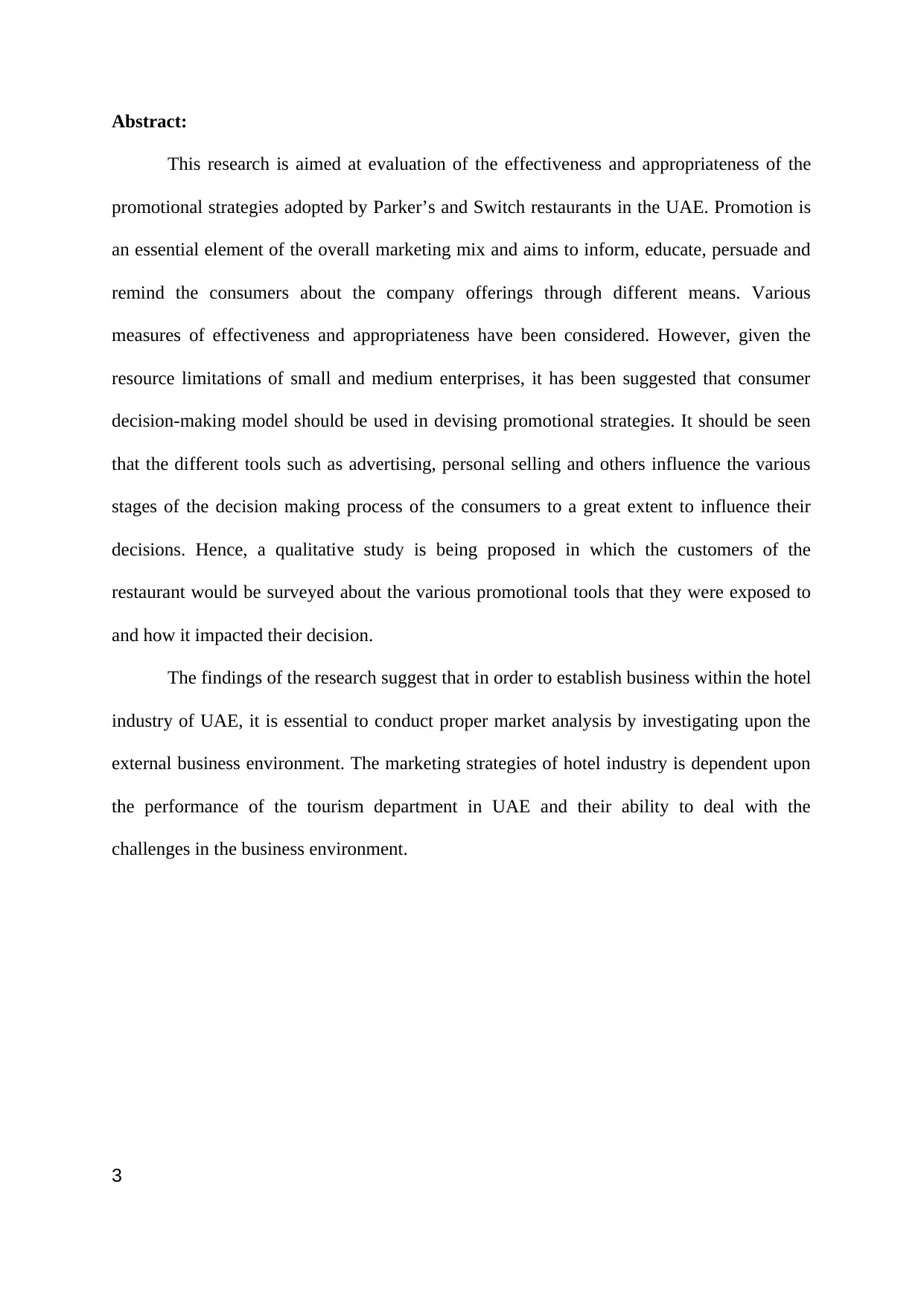
Abstract:
This research is aimed at evaluation of the effectiveness and appropriateness of the
promotional strategies adopted by Parker’s and Switch restaurants in the UAE. Promotion is
an essential element of the overall marketing mix and aims to inform, educate, persuade and
remind the consumers about the company offerings through different means. Various
measures of effectiveness and appropriateness have been considered. However, given the
resource limitations of small and medium enterprises, it has been suggested that consumer
decision-making model should be used in devising promotional strategies. It should be seen
that the different tools such as advertising, personal selling and others influence the various
stages of the decision making process of the consumers to a great extent to influence their
decisions. Hence, a qualitative study is being proposed in which the customers of the
restaurant would be surveyed about the various promotional tools that they were exposed to
and how it impacted their decision.
The findings of the research suggest that in order to establish business within the hotel
industry of UAE, it is essential to conduct proper market analysis by investigating upon the
external business environment. The marketing strategies of hotel industry is dependent upon
the performance of the tourism department in UAE and their ability to deal with the
challenges in the business environment.
3
This research is aimed at evaluation of the effectiveness and appropriateness of the
promotional strategies adopted by Parker’s and Switch restaurants in the UAE. Promotion is
an essential element of the overall marketing mix and aims to inform, educate, persuade and
remind the consumers about the company offerings through different means. Various
measures of effectiveness and appropriateness have been considered. However, given the
resource limitations of small and medium enterprises, it has been suggested that consumer
decision-making model should be used in devising promotional strategies. It should be seen
that the different tools such as advertising, personal selling and others influence the various
stages of the decision making process of the consumers to a great extent to influence their
decisions. Hence, a qualitative study is being proposed in which the customers of the
restaurant would be surveyed about the various promotional tools that they were exposed to
and how it impacted their decision.
The findings of the research suggest that in order to establish business within the hotel
industry of UAE, it is essential to conduct proper market analysis by investigating upon the
external business environment. The marketing strategies of hotel industry is dependent upon
the performance of the tourism department in UAE and their ability to deal with the
challenges in the business environment.
3
⊘ This is a preview!⊘
Do you want full access?
Subscribe today to unlock all pages.

Trusted by 1+ million students worldwide

APPENDIX 7 - DISSERTATION (PGBM73) DECLARATION
Statement of Originality and Authenticity
I confirm that the dissertation I am submitting is an original and authentic piece of work
written by myself that satisfies the University rules and regulations with respect to Plagiarism
and Collusion. I further confirm that I have fully referenced and acknowledged all material
incorporated as secondary resources in accordance with the Harvard system.
I also certify that I have taken a copy of the dissertation, which I will retain until after the
Board of Examiners has published the results, and which I will make available on request in
pursuance of any appropriate aspect of the marking and moderation of the work within the
University Regulations.
Name:
Registration Number:
Programme:
Study Centre:
Date:
Please note that Dissertations will not be assessed without the inclusion of this decla-ration
by the student
4
Statement of Originality and Authenticity
I confirm that the dissertation I am submitting is an original and authentic piece of work
written by myself that satisfies the University rules and regulations with respect to Plagiarism
and Collusion. I further confirm that I have fully referenced and acknowledged all material
incorporated as secondary resources in accordance with the Harvard system.
I also certify that I have taken a copy of the dissertation, which I will retain until after the
Board of Examiners has published the results, and which I will make available on request in
pursuance of any appropriate aspect of the marking and moderation of the work within the
University Regulations.
Name:
Registration Number:
Programme:
Study Centre:
Date:
Please note that Dissertations will not be assessed without the inclusion of this decla-ration
by the student
4
Paraphrase This Document
Need a fresh take? Get an instant paraphrase of this document with our AI Paraphraser
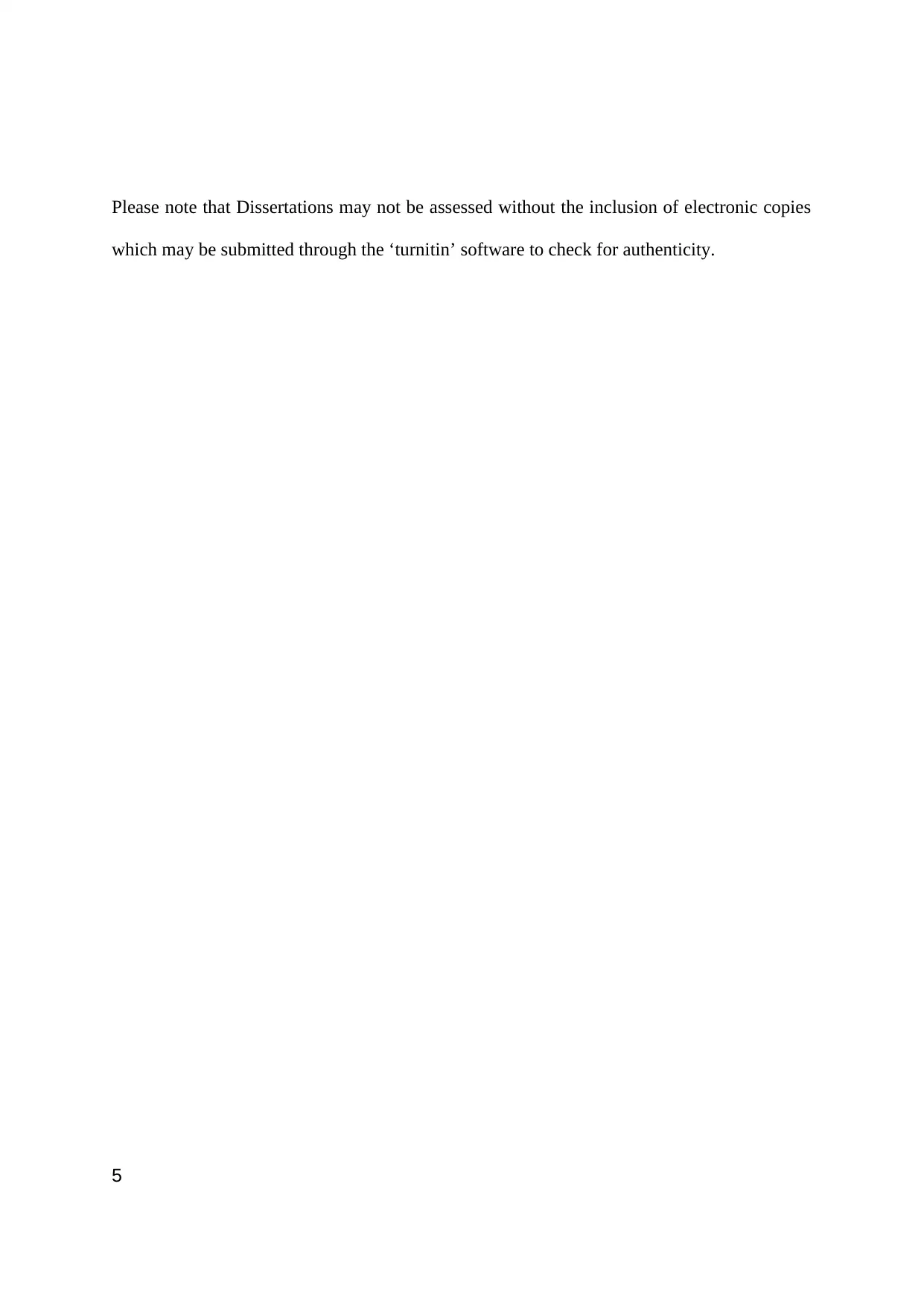
Please note that Dissertations may not be assessed without the inclusion of electronic copies
which may be submitted through the ‘turnitin’ software to check for authenticity.
5
which may be submitted through the ‘turnitin’ software to check for authenticity.
5
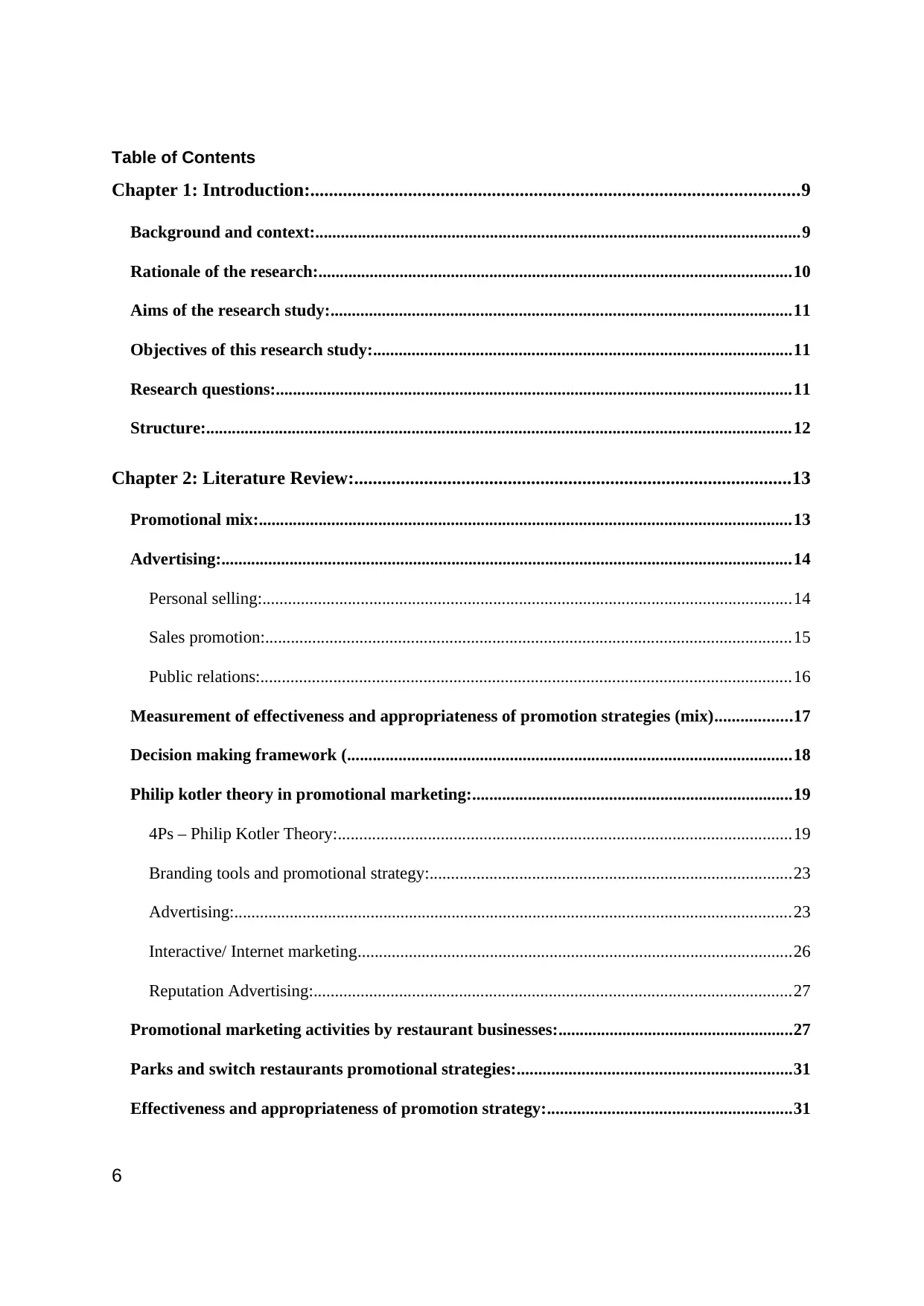
Table of Contents
Chapter 1: Introduction:.........................................................................................................9
Background and context:..................................................................................................................9
Rationale of the research:...............................................................................................................10
Aims of the research study:............................................................................................................11
Objectives of this research study:..................................................................................................11
Research questions:.........................................................................................................................11
Structure:.........................................................................................................................................12
Chapter 2: Literature Review:..............................................................................................13
Promotional mix:.............................................................................................................................13
Advertising:......................................................................................................................................14
Personal selling:............................................................................................................................14
Sales promotion:...........................................................................................................................15
Public relations:............................................................................................................................16
Measurement of effectiveness and appropriateness of promotion strategies (mix)..................17
Decision making framework (........................................................................................................18
Philip kotler theory in promotional marketing:...........................................................................19
4Ps – Philip Kotler Theory:..........................................................................................................19
Branding tools and promotional strategy:.....................................................................................23
Advertising:...................................................................................................................................23
Interactive/ Internet marketing......................................................................................................26
Reputation Advertising:................................................................................................................27
Promotional marketing activities by restaurant businesses:.......................................................27
Parks and switch restaurants promotional strategies:................................................................31
Effectiveness and appropriateness of promotion strategy:.........................................................31
6
Chapter 1: Introduction:.........................................................................................................9
Background and context:..................................................................................................................9
Rationale of the research:...............................................................................................................10
Aims of the research study:............................................................................................................11
Objectives of this research study:..................................................................................................11
Research questions:.........................................................................................................................11
Structure:.........................................................................................................................................12
Chapter 2: Literature Review:..............................................................................................13
Promotional mix:.............................................................................................................................13
Advertising:......................................................................................................................................14
Personal selling:............................................................................................................................14
Sales promotion:...........................................................................................................................15
Public relations:............................................................................................................................16
Measurement of effectiveness and appropriateness of promotion strategies (mix)..................17
Decision making framework (........................................................................................................18
Philip kotler theory in promotional marketing:...........................................................................19
4Ps – Philip Kotler Theory:..........................................................................................................19
Branding tools and promotional strategy:.....................................................................................23
Advertising:...................................................................................................................................23
Interactive/ Internet marketing......................................................................................................26
Reputation Advertising:................................................................................................................27
Promotional marketing activities by restaurant businesses:.......................................................27
Parks and switch restaurants promotional strategies:................................................................31
Effectiveness and appropriateness of promotion strategy:.........................................................31
6
⊘ This is a preview!⊘
Do you want full access?
Subscribe today to unlock all pages.

Trusted by 1+ million students worldwide

Chapter 3: Research Methodology.......................................................................................35
Research Study Scenario:...............................................................................................................35
Inductive approach:.......................................................................................................................35
Deductive approach:.....................................................................................................................36
Mixed Approach...........................................................................................................................36
Quantitative research methods......................................................................................................37
Qualitative research method :........................................................................................................37
Research Philosophy.......................................................................................................................38
Research design...............................................................................................................................39
Population Frame:...........................................................................................................................40
Sample Size:.....................................................................................................................................40
Instrument Development:...............................................................................................................40
Researching strategy:......................................................................................................................41
Investigation:...................................................................................................................................41
Sampling:.........................................................................................................................................41
Data Collection:...............................................................................................................................42
Data Analysis:..................................................................................................................................43
Ethical issues and validly................................................................................................................43
Research Limitations:.....................................................................................................................43
Conclusion:.......................................................................................................................................44
Questionnaire and Survey data:...........................................................................................45
Chapeter 4: Data presentation..............................................................................................48
Results and Discussions:.................................................................................................................63
Correlation results.........................................................................................................................63
Regression analysis.......................................................................................................................66
Chapter 5: Conclusions and recommendations...................................................................72
7
Research Study Scenario:...............................................................................................................35
Inductive approach:.......................................................................................................................35
Deductive approach:.....................................................................................................................36
Mixed Approach...........................................................................................................................36
Quantitative research methods......................................................................................................37
Qualitative research method :........................................................................................................37
Research Philosophy.......................................................................................................................38
Research design...............................................................................................................................39
Population Frame:...........................................................................................................................40
Sample Size:.....................................................................................................................................40
Instrument Development:...............................................................................................................40
Researching strategy:......................................................................................................................41
Investigation:...................................................................................................................................41
Sampling:.........................................................................................................................................41
Data Collection:...............................................................................................................................42
Data Analysis:..................................................................................................................................43
Ethical issues and validly................................................................................................................43
Research Limitations:.....................................................................................................................43
Conclusion:.......................................................................................................................................44
Questionnaire and Survey data:...........................................................................................45
Chapeter 4: Data presentation..............................................................................................48
Results and Discussions:.................................................................................................................63
Correlation results.........................................................................................................................63
Regression analysis.......................................................................................................................66
Chapter 5: Conclusions and recommendations...................................................................72
7
Paraphrase This Document
Need a fresh take? Get an instant paraphrase of this document with our AI Paraphraser

Chapter 6: Personal Development........................................................................................76
Recommendations for the restaurant industry in UAE:.............................................................77
Bibliography...........................................................................................................................80
Appendix 1 – Research proposal..........................................................................................86
Appendix 2..............................................................................................................................87
8
Recommendations for the restaurant industry in UAE:.............................................................77
Bibliography...........................................................................................................................80
Appendix 1 – Research proposal..........................................................................................86
Appendix 2..............................................................................................................................87
8
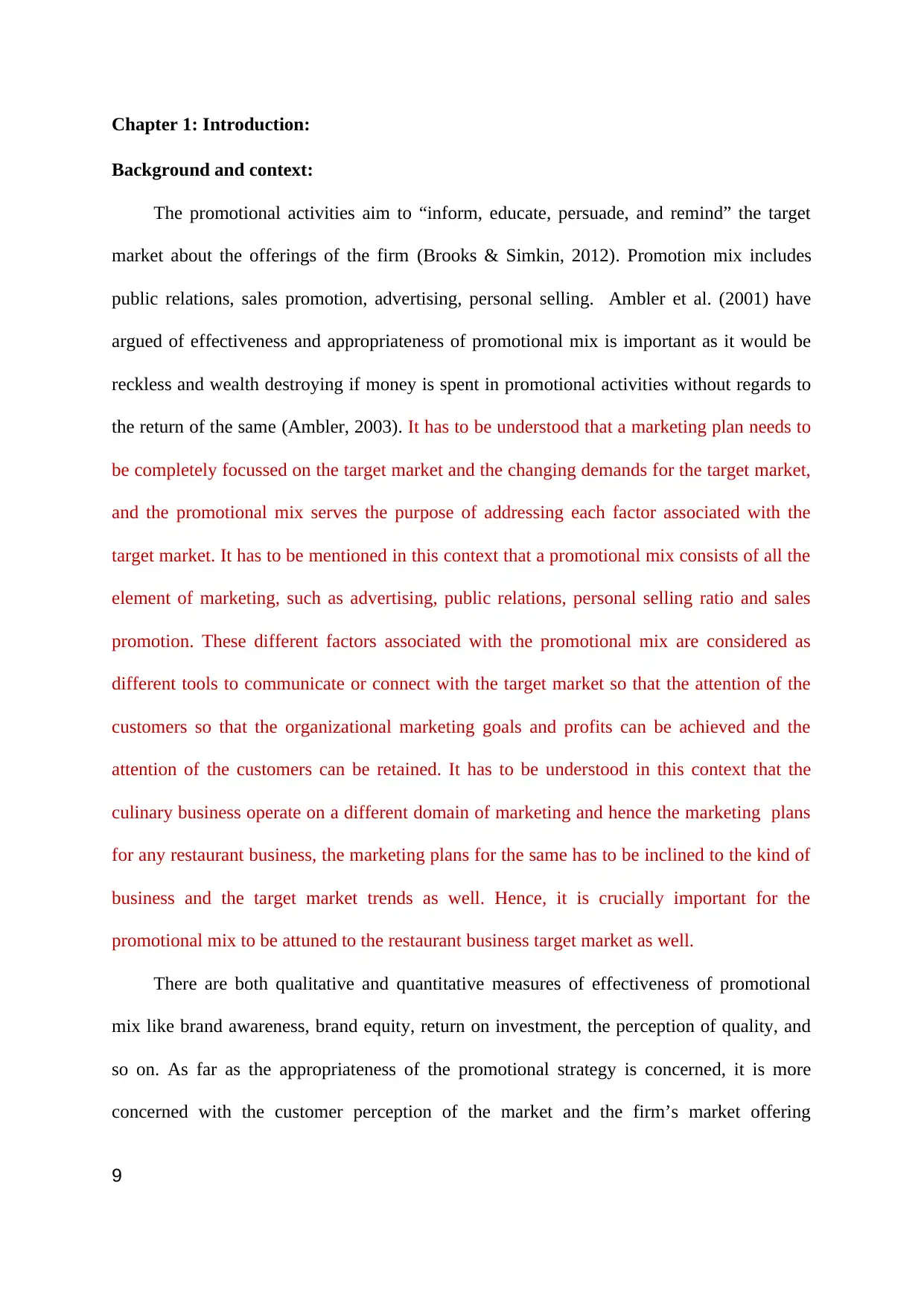
Chapter 1: Introduction:
Background and context:
The promotional activities aim to “inform, educate, persuade, and remind” the target
market about the offerings of the firm (Brooks & Simkin, 2012). Promotion mix includes
public relations, sales promotion, advertising, personal selling. Ambler et al. (2001) have
argued of effectiveness and appropriateness of promotional mix is important as it would be
reckless and wealth destroying if money is spent in promotional activities without regards to
the return of the same (Ambler, 2003). It has to be understood that a marketing plan needs to
be completely focussed on the target market and the changing demands for the target market,
and the promotional mix serves the purpose of addressing each factor associated with the
target market. It has to be mentioned in this context that a promotional mix consists of all the
element of marketing, such as advertising, public relations, personal selling ratio and sales
promotion. These different factors associated with the promotional mix are considered as
different tools to communicate or connect with the target market so that the attention of the
customers so that the organizational marketing goals and profits can be achieved and the
attention of the customers can be retained. It has to be understood in this context that the
culinary business operate on a different domain of marketing and hence the marketing plans
for any restaurant business, the marketing plans for the same has to be inclined to the kind of
business and the target market trends as well. Hence, it is crucially important for the
promotional mix to be attuned to the restaurant business target market as well.
There are both qualitative and quantitative measures of effectiveness of promotional
mix like brand awareness, brand equity, return on investment, the perception of quality, and
so on. As far as the appropriateness of the promotional strategy is concerned, it is more
concerned with the customer perception of the market and the firm’s market offering
9
Background and context:
The promotional activities aim to “inform, educate, persuade, and remind” the target
market about the offerings of the firm (Brooks & Simkin, 2012). Promotion mix includes
public relations, sales promotion, advertising, personal selling. Ambler et al. (2001) have
argued of effectiveness and appropriateness of promotional mix is important as it would be
reckless and wealth destroying if money is spent in promotional activities without regards to
the return of the same (Ambler, 2003). It has to be understood that a marketing plan needs to
be completely focussed on the target market and the changing demands for the target market,
and the promotional mix serves the purpose of addressing each factor associated with the
target market. It has to be mentioned in this context that a promotional mix consists of all the
element of marketing, such as advertising, public relations, personal selling ratio and sales
promotion. These different factors associated with the promotional mix are considered as
different tools to communicate or connect with the target market so that the attention of the
customers so that the organizational marketing goals and profits can be achieved and the
attention of the customers can be retained. It has to be understood in this context that the
culinary business operate on a different domain of marketing and hence the marketing plans
for any restaurant business, the marketing plans for the same has to be inclined to the kind of
business and the target market trends as well. Hence, it is crucially important for the
promotional mix to be attuned to the restaurant business target market as well.
There are both qualitative and quantitative measures of effectiveness of promotional
mix like brand awareness, brand equity, return on investment, the perception of quality, and
so on. As far as the appropriateness of the promotional strategy is concerned, it is more
concerned with the customer perception of the market and the firm’s market offering
9
⊘ This is a preview!⊘
Do you want full access?
Subscribe today to unlock all pages.

Trusted by 1+ million students worldwide
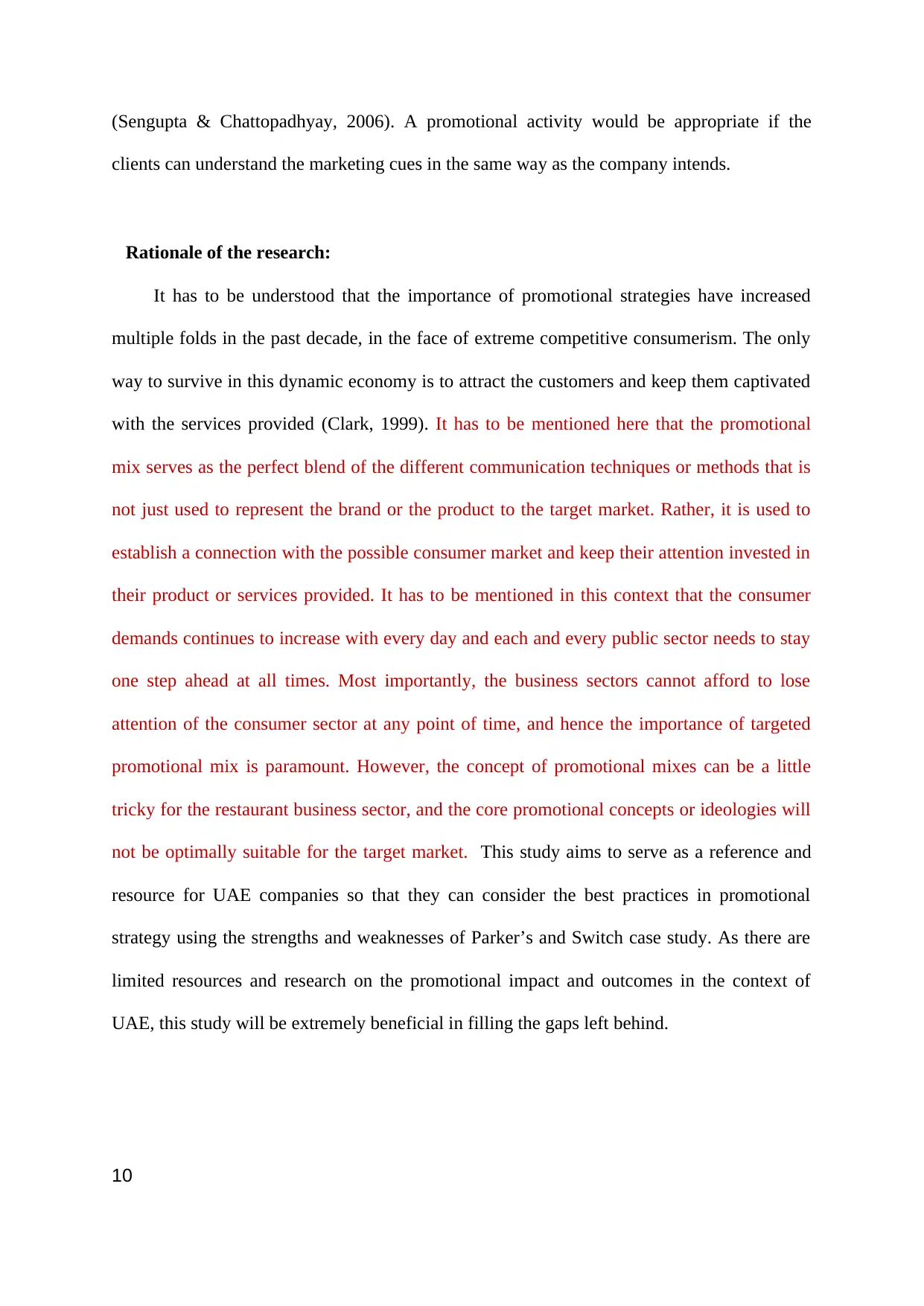
(Sengupta & Chattopadhyay, 2006). A promotional activity would be appropriate if the
clients can understand the marketing cues in the same way as the company intends.
Rationale of the research:
It has to be understood that the importance of promotional strategies have increased
multiple folds in the past decade, in the face of extreme competitive consumerism. The only
way to survive in this dynamic economy is to attract the customers and keep them captivated
with the services provided (Clark, 1999). It has to be mentioned here that the promotional
mix serves as the perfect blend of the different communication techniques or methods that is
not just used to represent the brand or the product to the target market. Rather, it is used to
establish a connection with the possible consumer market and keep their attention invested in
their product or services provided. It has to be mentioned in this context that the consumer
demands continues to increase with every day and each and every public sector needs to stay
one step ahead at all times. Most importantly, the business sectors cannot afford to lose
attention of the consumer sector at any point of time, and hence the importance of targeted
promotional mix is paramount. However, the concept of promotional mixes can be a little
tricky for the restaurant business sector, and the core promotional concepts or ideologies will
not be optimally suitable for the target market. This study aims to serve as a reference and
resource for UAE companies so that they can consider the best practices in promotional
strategy using the strengths and weaknesses of Parker’s and Switch case study. As there are
limited resources and research on the promotional impact and outcomes in the context of
UAE, this study will be extremely beneficial in filling the gaps left behind.
10
clients can understand the marketing cues in the same way as the company intends.
Rationale of the research:
It has to be understood that the importance of promotional strategies have increased
multiple folds in the past decade, in the face of extreme competitive consumerism. The only
way to survive in this dynamic economy is to attract the customers and keep them captivated
with the services provided (Clark, 1999). It has to be mentioned here that the promotional
mix serves as the perfect blend of the different communication techniques or methods that is
not just used to represent the brand or the product to the target market. Rather, it is used to
establish a connection with the possible consumer market and keep their attention invested in
their product or services provided. It has to be mentioned in this context that the consumer
demands continues to increase with every day and each and every public sector needs to stay
one step ahead at all times. Most importantly, the business sectors cannot afford to lose
attention of the consumer sector at any point of time, and hence the importance of targeted
promotional mix is paramount. However, the concept of promotional mixes can be a little
tricky for the restaurant business sector, and the core promotional concepts or ideologies will
not be optimally suitable for the target market. This study aims to serve as a reference and
resource for UAE companies so that they can consider the best practices in promotional
strategy using the strengths and weaknesses of Parker’s and Switch case study. As there are
limited resources and research on the promotional impact and outcomes in the context of
UAE, this study will be extremely beneficial in filling the gaps left behind.
10
Paraphrase This Document
Need a fresh take? Get an instant paraphrase of this document with our AI Paraphraser
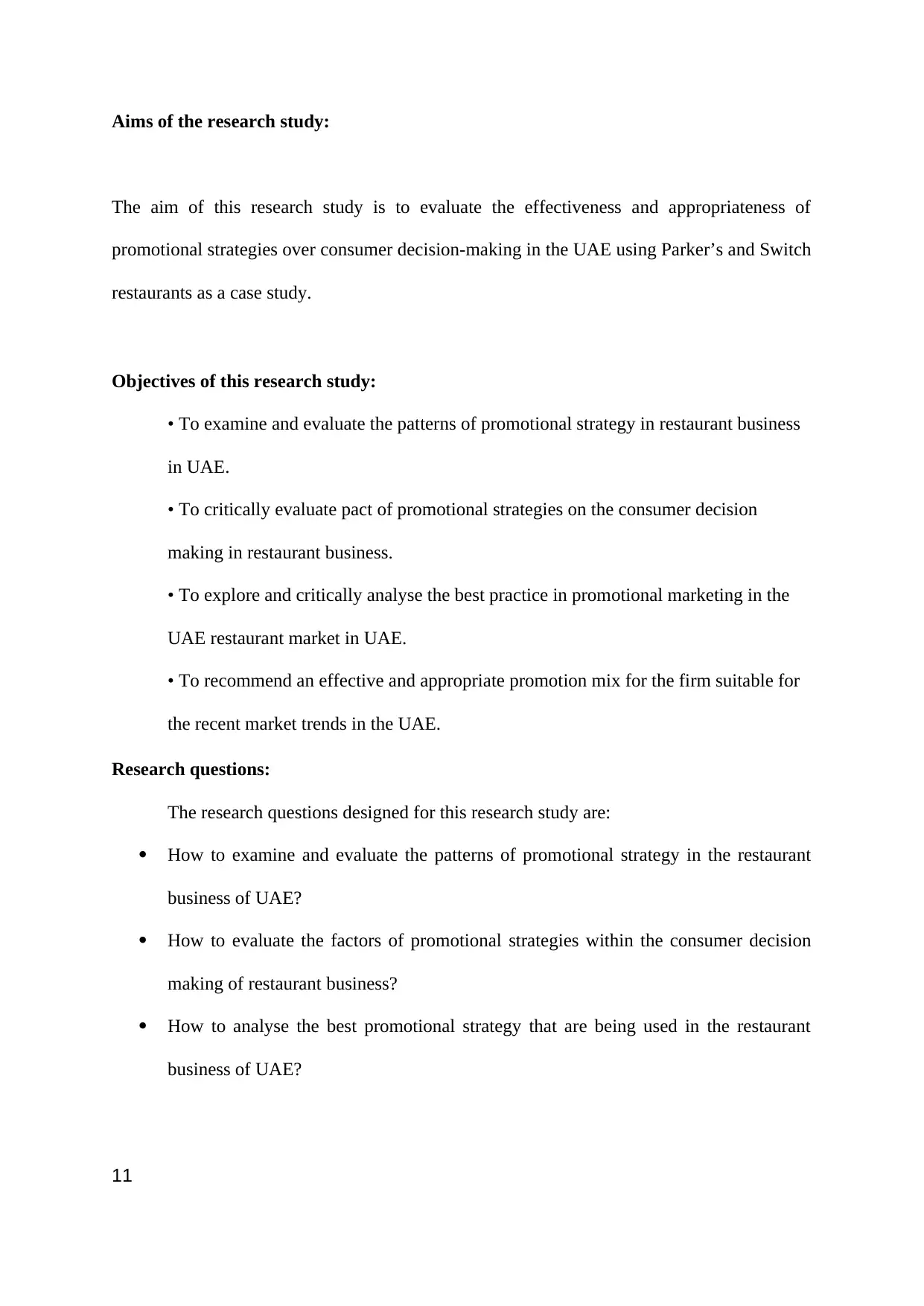
Aims of the research study:
The aim of this research study is to evaluate the effectiveness and appropriateness of
promotional strategies over consumer decision-making in the UAE using Parker’s and Switch
restaurants as a case study.
Objectives of this research study:
• To examine and evaluate the patterns of promotional strategy in restaurant business
in UAE.
• To critically evaluate pact of promotional strategies on the consumer decision
making in restaurant business.
• To explore and critically analyse the best practice in promotional marketing in the
UAE restaurant market in UAE.
• To recommend an effective and appropriate promotion mix for the firm suitable for
the recent market trends in the UAE.
Research questions:
The research questions designed for this research study are:
How to examine and evaluate the patterns of promotional strategy in the restaurant
business of UAE?
How to evaluate the factors of promotional strategies within the consumer decision
making of restaurant business?
How to analyse the best promotional strategy that are being used in the restaurant
business of UAE?
11
The aim of this research study is to evaluate the effectiveness and appropriateness of
promotional strategies over consumer decision-making in the UAE using Parker’s and Switch
restaurants as a case study.
Objectives of this research study:
• To examine and evaluate the patterns of promotional strategy in restaurant business
in UAE.
• To critically evaluate pact of promotional strategies on the consumer decision
making in restaurant business.
• To explore and critically analyse the best practice in promotional marketing in the
UAE restaurant market in UAE.
• To recommend an effective and appropriate promotion mix for the firm suitable for
the recent market trends in the UAE.
Research questions:
The research questions designed for this research study are:
How to examine and evaluate the patterns of promotional strategy in the restaurant
business of UAE?
How to evaluate the factors of promotional strategies within the consumer decision
making of restaurant business?
How to analyse the best promotional strategy that are being used in the restaurant
business of UAE?
11

What are the recommendations for improving the effective and appropriate promotion
mix strategy suitable for the market of UAE?
Structure:
Chapter 1: Introduction: The first chapter of this paper discuses the background-
context, rationale of research, aims, objectives and the research questions. From the given
back ground information, it will be possible to highlight upon the research issues and the
methods that can be followed for the research.
Chapter 2: Literature Review: The second chapter is the literature review that focuses on
the different variables of promotional mixes and their suitability in the restaurant business
sectors. This section will also critically evaluate the relevant existing literature of the given
research topic.
Chapter 3: Research Methodology: The third chapter is the research methodology, which
discusses the study design, research philosophy, data collection technique, data analysis
technique, and search strategy will be discussed. Proper justification for each of the chosen
techniques will also be provided. The chapter will also highlight the points about the
quantitate and qualitative research.
Chapter 4: Data Analysis: The fourth chapter will be data collection and analysis where
both primary and secondary data will be collected and analysis; and the deciphering or
interpretation of the results will be in the following section.
Chapter 5: Conclusion and Recommendations: The next chapter in discussion where the
findings and its connection with the previously published literature will be discussed. The
similarities of the current findings from that of the previous ones will be discussed
accordingly.
12
mix strategy suitable for the market of UAE?
Structure:
Chapter 1: Introduction: The first chapter of this paper discuses the background-
context, rationale of research, aims, objectives and the research questions. From the given
back ground information, it will be possible to highlight upon the research issues and the
methods that can be followed for the research.
Chapter 2: Literature Review: The second chapter is the literature review that focuses on
the different variables of promotional mixes and their suitability in the restaurant business
sectors. This section will also critically evaluate the relevant existing literature of the given
research topic.
Chapter 3: Research Methodology: The third chapter is the research methodology, which
discusses the study design, research philosophy, data collection technique, data analysis
technique, and search strategy will be discussed. Proper justification for each of the chosen
techniques will also be provided. The chapter will also highlight the points about the
quantitate and qualitative research.
Chapter 4: Data Analysis: The fourth chapter will be data collection and analysis where
both primary and secondary data will be collected and analysis; and the deciphering or
interpretation of the results will be in the following section.
Chapter 5: Conclusion and Recommendations: The next chapter in discussion where the
findings and its connection with the previously published literature will be discussed. The
similarities of the current findings from that of the previous ones will be discussed
accordingly.
12
⊘ This is a preview!⊘
Do you want full access?
Subscribe today to unlock all pages.

Trusted by 1+ million students worldwide
1 out of 86
Related Documents
Your All-in-One AI-Powered Toolkit for Academic Success.
+13062052269
info@desklib.com
Available 24*7 on WhatsApp / Email
![[object Object]](/_next/static/media/star-bottom.7253800d.svg)
Unlock your academic potential
Copyright © 2020–2026 A2Z Services. All Rights Reserved. Developed and managed by ZUCOL.





